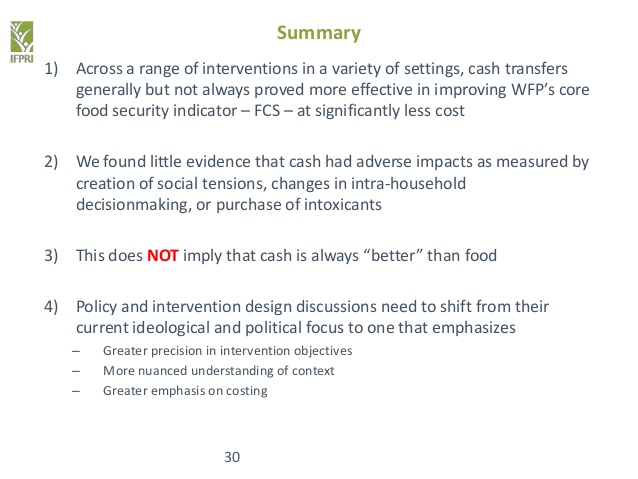Cash versus food, four experiments in four countries
Subscribe to Blog
Recent Posts
When is War Justified?
October 24, 2022
Conversation with Teny Gross on Gang Violence
October 20, 2022
The 5 reasons wars happen
October 14, 2022
Advanced Master’s & PhDs
September 10, 2022


36 Responses
Did they measure any increase or decrease of dependency relative to the cash aid or food aid. But maybe the beneficiaries of both types of aid were not farmers.
Also if food could be bought locally with the cash aid it does suggest that food was grown locally or at least somewhere nearby. This brings the thought as to why some received the aid when, typically unless it is a humanitarian disaster, others would have been selling food surplus. This is a typical scenario. Food surplus producers are selling their food surplus to people who receive cash aid in the very same community. Some are genuine cases in need but some are on dependency.
There is a stat somewhere that shows that 80 per cent of the food grown by small holders is grown by 20 per cent of the small holders. So 80 per cent of the small holders grow 20 per cent of the food. This is all in the same communities with the same rain, soil, etc. It is a point not addressed and harmful to agricultural production, personal and national prosperity.
I feel the budgets on food aid should be diverted to food production except in a few cases. The issue then of whether it rains in the USA or Canada would not be so important.
RT @Give_Directly: Cash vs. Food, 4 experiments in 4 countries: http://t.co/egVXoLy1bt
Cash vs. Food, 4 experiments in 4 countries: http://t.co/egVXoLy1bt
RT @bill_easterly: Giving cash to the poor is better than giving food http://t.co/R6xFetofq9
RT @bill_easterly: Giving cash to the poor is better than giving food http://t.co/R6xFetofq9
RT @bill_easterly: Giving cash to the poor is better than giving food http://t.co/R6xFetofq9
RT @cblatts: Cash versus food, four experiments in four countries http://t.co/vbyDzQhllz
RT @cblatts: Cash versus food, four experiments in four countries http://t.co/vbyDzQhllz
RT @cblatts: Cash versus food, four experiments in four countries http://t.co/vbyDzQhllz
RT @cblatts: Cash versus food, four experiments in four countries http://t.co/vbyDzQhllz
RT @bill_easterly: Giving cash to the poor is better than giving food http://t.co/R6xFetofq9
“Cash versus food, four experiments in four countries” http://t.co/0EDn8ARdEH
What would you give to the poor? Cash vs Food. Four experiments in four countries. http://t.co/BVFZjU5C7W
RT @bill_easterly: Giving cash to the poor is better than giving food http://t.co/R6xFetofq9
RT @bill_easterly: Giving cash to the poor is better than giving food http://t.co/R6xFetofq9
RT @cblatts: Cash versus food, four experiments in four countries http://t.co/vbyDzQhllz
RT @cblatts: Cash versus food, four experiments in four countries http://t.co/vbyDzQhllz
RT @cblatts: Cash versus food, four experiments in four countries http://t.co/vbyDzQhllz
Cash versus food, four experiments in four countries http://t.co/Ux1KN2Wl6W
RT @cblatts: Cash versus food, four experiments in four countries http://t.co/vbyDzQhllz
RT @fp2p: Cash versus food, four experiments in four countries (cash wins, acc to @ifpri). #cashtransfers #foodaid http://t.co/NAljaf1WsE
RT @ithorpe: Cash versus food, four experiments in four countries – nice summary of @ifpri research via @cblatts http://t.co/1LgLCBG1IT
RT @ithorpe: Cash versus food, four experiments in four countries – nice summary of @ifpri research via @cblatts http://t.co/1LgLCBG1IT
Cash versus food, four experiments in four countries – nice summary of @ifpri research via @cblatts http://t.co/1LgLCBG1IT
“@fp2p: Cash versus food, four experiments in four countries (cash wins, acc to @ifpri). #cashtransfers #foodaid http://t.co/q7u8CuKZga”
RT @fp2p: Cash versus food, four experiments in four countries (cash wins, acc to @ifpri). #cashtransfers #foodaid http://t.co/NAljaf1WsE
Cash versus food, four experiments in four countries (cash wins, acc to @ifpri). #cashtransfers #foodaid http://t.co/NAljaf1WsE
Cash versus food, four experiments in four countries: A slide presentation from IFPRI’s John Hoddinott. Here i… http://t.co/fcgViKh3Xx
Cash transfers more effective than food but depends on context and there should be more focus on costs http://t.co/8ZXAmbOFFo @cblatts
RT @cblatts: Cash versus food, four experiments in four countries http://t.co/vbyDzQhllz
RT @cblatts: Cash versus food, four experiments in four countries http://t.co/vbyDzQhllz
RT @cblatts: Cash versus food, four experiments in four countries http://t.co/vbyDzQhllz
Cash versus food, four experiments in four countries http://t.co/IHjvVtitFC If @cblatts quotes it, it must be true!
RT @cblatts: Cash versus food, four experiments in four countries http://t.co/vbyDzQhllz
You had me at “experiments”, Chris. RT @cblatts: Cash versus food, four experiments in four countries http://t.co/5uHw2wnytU
RT @cblatts: Cash versus food, four experiments in four countries http://t.co/vbyDzQhllz